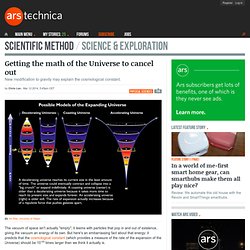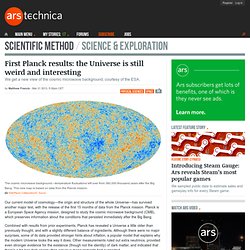

Dark Matter & Dark Energy. What is the Universe Expanding Into? Come on, admit it, you’ve had this question.

“Since astronomers know that the Universe is expanding, what’s it expanding into? What’s outside of the Universe?” Ask any astronomer and you’ll get an unsatisfying answer. We give you the same unsatisfying answer, but really explain it, so your unsatisfaction doesn’t haunt you any more. The short answer is that this is a nonsense question, the Universe isn’t expanding into anything, it’s just expanding. Cosmic microwave background. The cosmic microwave background (CMB) is the thermal radiation assumed to be left over from the "Big Bang" of cosmology.

In older literature, the CMB is also variously known as cosmic microwave background radiation (CMBR) or "relic radiation. " The CMB is a cosmic background radiation that is fundamental to observational cosmology because it is the oldest light in the universe, dating to the epoch of recombination. With a traditional optical telescope, the space between stars and galaxies (the background) is completely dark. However, a sufficiently sensitive radio telescope shows a faint background glow, almost exactly the same in all directions, that is not associated with any star, galaxy, or other object. Major Discovery: 'Smoking Gun' for Universe's Incredible Big Bang Expansion Found. Astronomers have found the first direct evidence of cosmic inflation, the theorized dramatic expansion of the universe that put the "bang" in the Big Bang 13.8 billion years ago, new research suggests.

If it holds up, the landmark discovery — which also confirms the existence of hypothesized ripples in space-time known as gravitational waves — would give researchers a much better understanding of the Big Bang and its immediate aftermath. The sun sets behind BICEP2 (in the foreground) and the South Pole Telescope (in the background).Credit: Steffen Richter (Harvard University) The Big Bang to Civilization: 10 Amazing Origin Events. By Roger Briggs | December 12, 2013 05:57pm ET Credit: CERN.

Colorful Hubble Telescope Image Is Best-Ever View of Universe's Evolution (Video) BOSTON — The Hubble Space Telescope has captured an amazing and colorful deep view of the universe, showing galaxies shining in ultraviolet light during their wild, star-forming "teenage" years.

The new image, which was released today (June 3), is the most comprehensive view of the evolving universe ever captured by the space telescope, Hubble representatives said. Hubble previously imaged the same patch of sky shown in the new image between 2004 and 2009 to create a super-detailed view known as the Hubble Ultra Deep Field. Story of the Biggest Experiment in History Caught on Film. On July 4, 2012, scientists around the world waited with bated breath for the announcement that the long-awaited Higgs boson particle had been discovered.

Is the lopsided Universe telling us we need new theories? The Universe is incredibly regular. The variation of the cosmos' temperature across the entire sky is tiny: a few millionths of a degree, no matter which direction you look. Yet the same light from the very early cosmos that reveals the Universe's evenness also tells astronomers a great deal about the conditions that gave rise to irregularities like stars, galaxies, and (incidentally) us.
That light is the cosmic microwave background, and it provides some of the best knowledge we have about the structure, content, and history of the Universe. But it also contains a few mysteries: on very large scales, the cosmos seems to have a certain lopsidedness. That slight asymmetry is reflected in temperature fluctuations much larger than any galaxy, aligned on the sky in a pattern facetiously dubbed "the axis of evil.” Getting the math of the Universe to cancel out. The vacuum of space isn't actually "empty"; it teems with particles that pop in and out of existence, giving the vacuum an energy of its own.

But here's an embarrassing fact about that energy: it predicts that the cosmological constant (which provides a measure of the rate of the expansion of the Universe) should be 10120 times larger than we think it actually is. Most scientists prefer things to be a bit more accurate than this. Still, the main question on cosmologists' minds is not why the predicted and real values appear to be so different, but how it is that the vacuum energy does so little. An answer of sorts has recently appeared in Physical Review Letters. Stephen Hawking at 70: still the brightest star in the scientific universe. Professor of mathematics and astronomy, Queen Mary, University of London.

Stephen Hawking's PhD student 1972-75 Stephen's discovery in 1974 that black holes emit thermal radiation due to quantum effects was one of the most important results in 20th-century physics. This is because it unified three previously disparate areas of physics – quantum theory, general relativity and thermodynamics. Like all such unifying ideas, it is so beautiful that it almost has to be true, even though it has still not been experimentally confirmed. The renowned physicist John Wheeler once told me that just talking about it was like "rolling candy on the tongue".
At the time of the discovery, I was working with him as a PhD student in Cambridge and I count myself as very fortunate to have had a ringside seat during these developments. I was one of Stephen's first PhD students and people often ask me what it was like having him as a supervisor. I also travelled around China with him in 1985. Stephen Hawking, everything you need to know – infographic. First Planck results: the Universe is still weird and interesting. Our current model of cosmology—the origin and structure of the whole Universe—has survived another major test, with the release of the first 15 months of data from the Planck mission.

Planck is a European Space Agency mission, designed to study the cosmic microwave background (CMB), which preserves information about the conditions that persisted immediately after the Big Bang. Combined with results from prior experiments, Planck has revealed a Universe a little older than previously thought, and with a slightly different balance of ingredients. Although there were no major surprises, some of its data provided stronger hints about inflation, a popular model that explains why the modern Universe looks the way it does. Other measurements ruled out extra neutrinos, provided even stronger evidence for the existence (though not the identity) of dark matter, and indicated that there's a bit less dark energy than previous measurements had suggested.
Enigmatic Flashes from the Edge of the Cosmos - Out There. They come from somewhere in the distant universe–probably some 6 billion to 11 billion light years away.

They don’t last very long, only about one-thousandth of a second. They happen all the time, up to 10,000 times a day. They create intense bursts of radio emission but nothing else–no light, no x-rays, no other visible evidence. And nobody knows what they are. Until now, nobody was even sure they existed. Cosmic Mystery Box Contents Deduced - Space News. Image Caption: Cosmic rays are thought to originate in nests of massive stars called OB associations, like this one in the Tarantula Nebula in the Large Magellanic Cloud, a satellite galaxy of the Milky Way. But how did scientists figure that out? Credit: NASA, ESA, & F. Paresce (INAF-IASF), R. O’Connell (U. Really, REALLY fast... That's how quickly the universe is expanding, according to most accurate estimate yet made by science.
The rate of expansion of the cosmos, known as Hubble's constant, is crucial for working out its age and size Nasa's Spitzer Space Telescope able to improve on previous estimates because its infrared vision sees through cosmic dust and debris By Damien Gayle Published: 09:38 GMT, 5 October 2012 | Updated: 12:21 GMT, 5 October 2012 Scientists have given the most accurate estimate yet of how fast the universe is expanding. A team of astronomers used Nasa's Spitzer Space Telescope to clock the expansion of the cosmos at a phenomenal 46 miles per second per megaparsec. American astronomer Edwin Hubble was in the Twenties first to discover that space is constantly expanding and has been growing continuously since its inception.
Are we the extra terrestrials? New study backs theory that life was brought to Earth by space microbes. By Mark Prigg Published: 15:33 GMT, 25 September 2012 | Updated: 17:15 GMT, 25 September 2012 Extraterrestrial microbes might have brought life to Earth after travelling through space for millions of years, say scientists. The theory is based on calculations showing a high likelihood of rock fragments from planets in other star systems landing on Earth long ago.
Some of them could have carried embedded micro-organisms, according to experts writing in the journal Astrobiology. Scroll down for Video Scientists believe life may have come to earth on a rock fragment from another planet. Is the secret of the 'previous' universe hidden in the microwaves? Scientist 'spots' ghost from before the Big Bang. By Eddie Wrenn Updated: 11:12 GMT, 11 June 2012 A renowned scientist says he has spotted evidence that a universe existed before the Big Bang. Amazing new pictures of the first moments following the Big Bang. By Daily Mail Reporter Published: 05:56 GMT, 8 June 2012 | Updated: 07:32 GMT, 8 June 2012 A space telescope has captured a glimpse back into the deepest reaches of time - just after the Big Bangm, 13.7 billion years ago. Einstein proved right over universe: General theory of relativity correctly measures the rapid expansion of space driven by mysterious 'dark energy'
Dark energy was only discovered 14 years agoTheory predicts how fast galaxies are moving apartEinstein's brain now on display at the Wellcome Trust in London By Ted Thornhill. Cosmos: A Personal Voyage. With Cosmos, Carl Sagan and his wife and co-writer, Ann Druyan, brilliantly illustrated the underlying science of his same-titled book, placing the human species within a space-and-time context that brought the infinite into stunningly clear view. The series, which originally aired in 1980 on PBS, has been seen by more than 700 million people worldwide and remains a high-water mark in miniseries history. Lawrence Krauss: Opinions on the Cosmos.
The Fabric of the Cosmos with Brian Greene: Watch the Complete NOVA Series Online. Forget about inclined planes and pulleys. In this series from the PBS program NOVA, physics is presented as an exotic, mind-bending realm. Scientists create hottest temperature since Big Bang - 250,000 times warmer than centre of the sun. By Eddie Wrenn for MailOnline Updated: 12:06 EDT, 27 June 2012.
Complex Organic Matter Discovered Created by Stars Throughout the Universe. Introduction to Cosmology. Cookies on the New Scientist website close Our website uses cookies, which are small text files that are widely used in order to make websites work more effectively. To continue using our website and consent to the use of cookies, click away from this box or click 'Close' Find out about our cookies and how to change them.
The History of the Universe in 200 Words or Less. Quantum fluctuation. Cosmology: the first people ever to spot "dark galaxies"